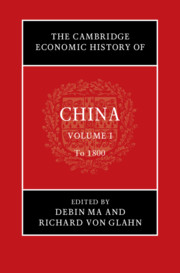Book contents
- The Cambridge Economic History of China
- The Cambridge Economic History of China
- The Cambridge Economic History of China
- Copyright page
- Contents
- Figures
- Maps
- Tables
- Contributors to Volume I
- Acknowledgments
- Note on Citations
- Introduction to Volume I
- Part I Before 1000
- Interlude
- Part II 1000 to 1800
- Bibliography of Primary Works Cited
- Index
- References
Part I - Before 1000
Published online by Cambridge University Press: 07 February 2022
- The Cambridge Economic History of China
- The Cambridge Economic History of China
- The Cambridge Economic History of China
- Copyright page
- Contents
- Figures
- Maps
- Tables
- Contributors to Volume I
- Acknowledgments
- Note on Citations
- Introduction to Volume I
- Part I Before 1000
- Interlude
- Part II 1000 to 1800
- Bibliography of Primary Works Cited
- Index
- References
Summary

- Type
- Chapter
- Information
- The Cambridge Economic History of China , pp. 13 - 240Publisher: Cambridge University PressPrint publication year: 2022

